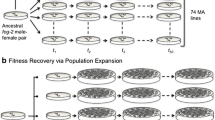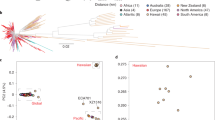Abstract
Evolutionary relationships across taxa can be deduced from sequence divergence of proteins, RNA, or DNA; sequences which diverge rapidly, such as those of mitochondrial genes, have been especially useful for comparisons of closely related species, and-within limits—of strains within a species. We have utilized the transposable element Tcl as a polymorphic marker to evaluate the evolutionary relationships among nine Caenorhabditis elegans strains. For five low-Tcl-copy strains, we compared patterns of restriction fragments hybridizing to a cloned Tc1 probe. Twenty of the 40 Tc1 insertion sites thus characterized were common to all five strains, and so presumably preceded strain divergence; the 20 differential bands were used to construct a maximum-parsimony tree relating these strains. In four high-copy-number stocks (three wild-type strains and a subline), we determined occupancy of 35 individual Tc1 insertion sites by a polymerase chain reaction assay. Surprisingly, the high-copy strains share a common subset of these Tc1 insertions, and the chromosomal distribution of conserved Tc 1 sites is “clustered” with respect to the other elements tested. These data imply a close evolutionary relationship among the high-copy strains, such that two of these strains appear to have been derived from the highest-copy-number lineage (represented by two stocks) through crossing with a low-Tc1 strain. Abundances of Tc1 elements were also estimated for the four high-copy-number stocks, at ∼200–500 copies per haploid genome, by quantitative dot-blot hybridization relative to two low-copy strains. Annealing with 32P-labeled probes corresponding to full-length Tc1, an oligonucleotide within the Tc1 terminal inverted repeats, and an internal Tc1 oligonucleotide, gave essentially identical results—indicating that Tc1 termini exist in the genome primarily as components of full-length Tc1 elements. A composite evolutionary tree is proposed, based on the locations and numbers of Tc1 elements in these strains, which is consistent with a four-branch intraspecific tree deduced previously by maximum-parsimony analyses of mitochondrial sequence changes; it also serves to elucidate the evolutionary history of transposon mobility.
Similar content being viewed by others
References
Abad P, Cerutti M, Pauron D, Quiles C, Palin B, Devauchelle G, Dalmasso A (1993) Expression and biochemical characterization of the DNA binding activity of TcA, the putative transposase of Caenorhabditis elegans transposable element Tc1. Biochem Biophys Res Comm 192:1445–1452
Abad P, Quiles C, Tares S, Piotte C, Castagnone-Sereno P, Abadon M, Dalmasso A (1991) Sequences homologous to Tc(s) transposable elements of Caenorhabditis elegans are widely distributed in the phylum Nematoda. J Mol Evol 33:251–258
Babity JM, Starr TVB, Rose AM (1990) Tc1 transposition and mutator activity in a Bristol strain of Caenorhabditis elegans. Mol Gen Genet 222:65–70
Bregliano JC, Picard G, Bucheton A, Pelisson A, Lavige JM, et al. (1980) Hybrid dysgenesis in Drosophila melanogaster. Science 207:606–611
Brenner S (1974) The genetics of Caenorhabditis elegans. Genetics 77:71–94
Calos MP, Miller JH (1980) Transposable elements. Cell 20:579–595
Collins J, Saari B, Anderson P (1987) Activation of a transposable element in the germ line but not the soma of Caenorhabditis elegans. Nature 3328:726–728
Dreyfus DH, Emmons SW (1991) A transposon related palindromic repetitive sequence from C. elegans. Nucleic Acid Res 19:1871–1877
Ebert RH, Cherkasova VA, Dennis RA, Wu JH, Ruggles S, Eudy Perrin T, Shmookler Reis RJ (1993) Longevity-determining genes in Caenorhabditis elegans: Chromosomal mapping of multiple noninteractive loci. Genetics 135:1003–1010
Egilmez NK, Shmookler Reis RJ (1994) Age-dependent somatic excision of transposable element Tc1 in Caenorhabditis elegans. Mutat Res 316:17–24
Eide D, Anderson P (1985) The gene structure of spontaneous mutations affecting a Caenorhabditis elegans myosin heavy chain gene. Genetics 109:67–79
Eide D, Anderson P (1988) Insertion and excision of Caenorhabditis elegans transposable element Tc1. Mol Cell Biol 8:737–746
Emmons SW, Roberts S, Ruan K (1986) Evidence in a nematode for regulation of transposon excision by tissue-specific factors. Mol Gen Genet 202:410–415
Feinberg AP, Vogelstein B (1984) A technique for radiolabeling DNA restriction endonuclease fragments to high specific activity. Anal Biochem 137:266–267
Glantz SA (1981) Primer of biostatistics, 2nd ed. McGraw-Hill, New York
Harris LJ, Rose AM (1989) Structural analysis of Tc1 elements in Caenorhabditis elegans Var. Bristol (strain N2). Plasmid 22:10–21
Harris LJ, Prasad S, Rose AM (1990) Isolation and sequence analysis of Caenorhabditis briggsae repetitive elements related to the Caenorhabditis elegans transposon Tc1. J Mol Evol 30:359–369
Henikoff S (1992) Detection of Caenorhabditis elegans transposon homologs in diverse organisms. New Biol 4:382–388
Kachigan SK (1982) Statistical analysis. Radius Press, New York
Liao L, Rosenzweig B, Hirsh D (1983) Analysis of a transposable element in Caenorhabditis elegans. Proc Natl Acad Sci USA 80:3585–3589
Maynard Smith J (1960) Continuous, quantized and modal variation. Proc R Soc Lend [Biol] 152:397–409
McClintock B (1984) The significance of responses of the genome to challenge. Science 226:792–801
Moerman DG, Waterston RH (1984) Spontaneous unstable unc-22 IV mutations in C. elegans var. Bergerac. Genetics 108:859–877
Moerman DG, Waterston RH (1989) Mobile elements in C. elegans and other nematodes. In: Berg DE, Howe MM (eds) Mobile DNA. American Society for Microbiology, Washington, DC, p 537
Moreno MA, Chen J, Greenblatt I, DellaPorta SL (1992) Reconstitutional mutagenesis of the maize P gene by short-range Ac transpositions. Genetics 131:939–956
Mori I, Moerman DG, Waterston RH (1988) Analysis of a mutator activity necessary for germline transposition and excision of Tc1 transposable elements in Caenorhabditis elegans. Genetics 1120: 397–407
Mori I, Moerman DG, Waterston RH (1990) Interstrain crosses enhance excision of Tc1 transposable elements in Caenorhabditis elegans. Mol Gen Genet 220:251–255
Osborne BI, Corr CA, Prince JP, Hehl R, Tanksley SD, McCormack S, Baker B (1991) Ac transposition from a T-DNA can generate linked and unlinked clusters of insertions in the tomato genome. Genetics 129:833–844
Plasterk RHA (1991) The origin of footprints of the Tc1 transposon of Caenorhabditis elegans. EMBO J 10:1919–1925
Rosenzweig B, Liao LW, Hirsh D (1983) Sequence of the C. elegans transposable element Tc1. Nucleic Acids Res 11:4201–4210
Sambrook J, Fritsch EF, Maniatis T (1989) Molecular cloning: a laboratory manual, 2nd ed. Cold Spring Harbor Laboratory Press, Cold Spring Harbor, NY
Schukkink RF, Plasterk RHA (1990) TcA, the putative transposase of the C. elegans Tc1 transposon, has an N-terminal DNA binding domain. Nucleic Acids Res 18:895–900
Sulston J, Hodgkin J (1988) Methods. In: Wood WB (ed) The nematode Caenorhabditis elegans. Cold Spring Harbor Press, Cold Spring Harbor, NY, pp 587–606
Thomas WK, Wilson AC (1991) Mode and tempo of molecular evolution in the nematode Caenorhabditis: cytochrome oxidase II and calmodulin sequences. Genetics 128:269–279
Tower J, Karpen GH, Craig N, Spradling AC (1993) Preferential transposition of Drosophila P elements to nearby chromosomal sites. Genetics 133:347–359
Williams BD, Schrank B, Huynh C, Shownkeen R, Waterston RH (1992) A genetic mapping system in Caenorhabditis elegans based on polymorphic sequence-tagged sites. Genetics 131:609–624
Wilson R, Ainscough R, Anderson K, Baynes C, Berks M, et al. (1994) 2.2 Mb of contiguous nucleotide sequence from chromosome III of C. elegans. Nature 368:32–38
Wood WB (1988) Introduction to C. elegans Biology. In: Wood WB (ed) The nematode Caenorhabditis elegans. Cold Spring Harbor Laboratory, Cold Spring Harbor, NY, pp 1–16
Zwaal RR, Broeks A, van Meurs J, Groenen JTM, Plasterk RHA (1993) Target-selected gene inactivation in Caenorhabditis elegans by using a frozen transposon insertion mutant bank. Proc Natl Acad Sci USA 90:7431–7435
Author information
Authors and Affiliations
Additional information
Correspondence to: R.J. Shmookler Reis
Rights and permissions
About this article
Cite this article
Egilmez, N.K., Ebert, R.H. & Shmookler Reis, R.J. Strain evolution in Caenorhabditis elegans: Transposable elements as markers of interstrain evolutionary history. J Mol Evol 40, 372–381 (1995). https://doi.org/10.1007/BF00164023
Received:
Accepted:
Issue Date:
DOI: https://doi.org/10.1007/BF00164023




